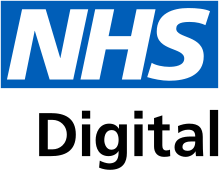NHS Digital
NHS Digital is the trading name of the Health and Social Care Information Centre, which is the national provider of information, data and IT systems for commissioners, analysts and clinicians in health and social care in England, particularly those involved with the National Health Service of England. The organisation is an executive non-departmental public body of the Department of Health and Social Care.[1]
 | |
 The headquarters of NHS Digital in Leeds | |
| Non-departmental public body overview | |
|---|---|
| Formed | 1 April 2013 |
| Preceding agencies |
|
| Jurisdiction | England |
| Headquarters | Leeds, England |
| Motto | Information and technology for better health and care |
| Employees | 6000 |
| Non-departmental public body executives |
|
| Parent department | Department of Health and Social Care |
| Website | digital |
Role
NHS Digital provides digital services for the NHS and social care, including the management of large health informatics programmes.[2] They deliver national systems through in-house teams, and by contracting private suppliers. These services include managing patient data including the Spine, which allows the secure sharing of information between different parts of the NHS, and forms the basis of the Electronic Prescription Service, Summary Care Record and Electronic Referral Service.[3]
NHS Digital is also the national collator of information about health and social care, and publishes over 260 statistical publications each year, including Official Statistics and National Statistics.[4] It also runs "The NHS Website" (www.nhs.uk, formerly NHS Choices), which is the national website for the NHS in England.
NHS Digital has taken on the roles of a number of predecessor bodies including the NHS Information Centre, NHS Connecting for Health, and parts of NHS Direct. The organisation produces more than 260 official and national statistical publications. This includes national comparative data for secondary uses, developed from the long-running Hospital Episode Statistics which can help local decision makers to improve the quality and efficiency of frontline care.
History
The organisation was created as a special health authority on 1 April 2005 by a merger of parts of the Department of Health, parts of the NHS Information Authority, and the Prescribing Support Unit.
Following the Health and Social Care Act 2012, the HSCIC changed from a special health authority to an executive non-departmental public body on 1 April 2013. Effective at this time, HSCIC took over parts of the troubled NHS National Programme for IT from the agency NHS Connecting for Health (CfH) which ceased to exist.[5] It also runs the Health Survey for England.
On 20 April 2016, it was announced that HSCIC would be rebranding, changing its name to NHS Digital in July 2016.[6][2]
NHSX, created in February 2019, has oversight of digital strategy and policy in NHS England. As a budget-holder, NHSX commissions projects from NHS Digital.[7]
Business areas
Handling patient data
NHS Digital runs the Spine service for the NHS, which is a central, secure system for patient data in England.[3] This enables a number of services for patients, including:
- the Electronic Prescription Service, which sends prescriptions digitally from GP surgeries and other NHS providers to pharmacies, without needing a printed prescription[8]
- the Summary Care Record which allows authorised NHS staff (such as hospital or ambulance staff) to see a summary of important information about a patient, to help give the best care.[9]
- the e-referral service which manages the booking of first time appointments with hospitals and specialists[10]
- the Child Protection - Information Sharing system, which helps ensure that any child protection concerns are known by the NHS when they are treated[11]
As the HSCIC, the organisation ran the care.data programme, which was cancelled in 2016.
NHS Digital collects the national 'Hospital Episode Statistics' (HES), which is a record of every 'episode' of admitted patient care (counted by completing care with a consultant, meaning that more than one episode can be associated with a single stay in hospital[12]) delivered by the NHS in England, including those done under contract by private providers. This involves the tracking of around 16 million 'episodes' of care every year.[13] This information is used for a range of statistical analysis, as well as for determining payments to providers. In addition to admitted patient care, HES also provides data for outpatient and emergency care encounters. The Emergency Care Data Set has been created to replace HES A&E data and provide better data on emergency care encounters.[14]
In November 2019 it launched the National Record Locator, which spans different health economies and is intended to enable paramedics, community mental health nurses, children’s health teams and maternity services to access the records of mental health patients across England.[15]
Central technology team
A troubleshooting operation was established in 2018 to help NHS trusts when major IT deployments go wrong. Eight trusts needed emergency assistance in 2018 after a deployment led to severe service disruptions. Funding of £2 million a year for the service has been allocated and expansion is expected.[16]
Statistics and data
NHS Digital compiles national data about the NHS and social care, with over 260 publications every year.[2] In addition, they provide data analysis, and access to data and clinical indicators.
Public-facing services
"The NHS Website" (www.nhs.uk, formerly NHS Choices) is the public website for the NHS Services in England, and is run by a team at NHS Digital, mandated by DOH with input from Public Health England.
References
- Annual Report 2016/17. NHS Digital.
- "HSCIC changing its name to NHS Digital". Department of Health.
- "Spine". NHS Digital.
- "List of National Statistics". UK Statistics Authority.
- "The Health and Social Care Information Centre Annual Report and Accounts 2011/12" (PDF). Retrieved 19 April 2014.
- Santry, Charlotte (20 April 2016). "HSCIC renamed NHS Digital and new chair hired". Health Service Journal.
- Crouch, Hannah (19 February 2019). "Digital Health News confirms new NHSX unit to oversee digital transformation". Digital Health. Retrieved 19 May 2020.
- "Electronic Prescription Service". NHS Digital.
- "Summary Care Records". NHS Digital.
- "NHS e-referral Service". NHS Digital.
- "Child Protection - Information Sharing". NHS Digital.
- "Hospital Episode Statistics (HES)". National Clinical Analysis and Specialised Applications Team. Retrieved 24 March 2015.
- "Hospital Episode Statistics". Health and Social Care Information Centre. Retrieved 24 March 2015.
- "Emergency Care Data Set (ECDS)". NHS Digital. Retrieved 31 March 2019.
- "National sharing of patient records enabled in first-of-kind initiative". Health Service Journal. 28 October 2019. Retrieved 8 December 2019.
- "New tech team to clean up trust IT fiascos". Health Service Journal. 24 October 2018. Retrieved 1 December 2018.